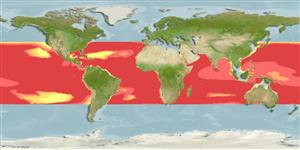Teleostei (teleosts) >
Stomiiformes (Lightfishes and dragonfishes) >
Sternoptychidae (Marine hatchetfishes) > Sternoptychinae
Etymology: Argyropelecus: Greek, argyros = silvered, silver + Greek, pelekys = axe (Ref. 45335).
More on author: Valenciennes.
Environment: milieu / climate zone / depth range / distribution range
Ecology
Marine; bathypelagic; depth range 100 - 2056 m (Ref. 27311). Deep-water; 40°N - 35°S, 180°W - 180°E
Eastern Atlantic: Portugal to Senegal; reported from Namibia (Ref. 27121). Western Atlantic: 40°N-10°N and 15°S-35°S; specimens taken off the Guianas (Ref. 13608). Northwest Atlantic: Canada (Ref. 5951). Indian Ocean: 0°-35°S. Western Pacific: 35°N-35°S. Southeast Pacific: 30°S-35°S. Recently reported in Aden Gulf, Arabian Sea (Ref. 85285).
Size / Weight / Age
Maturity: Lm ? range ? - ? cm
Max length : 8.3 cm SL male/unsexed; (Ref. 57911); max. published weight: 20.90 g (Ref. 124532)
An oceanic and mesopelagic species concentrated at 300-600 m by day and 100-300 by night (Refs. 4462, 4739). A selective dusk-time feeder mainly on conchoecid ostracods, to lesser extent on copepods, decapod larvae, fish larvae, etc (Ref. 4739). Adult photophore developing at about 15 mm SL (Ref. 4739). Also Ref. 58302.
Life cycle and mating behavior
Maturity | Reproduction | Spawning | Eggs | Fecundity | Larvae
Weitzman, S.H., 1986. Sternoptychidae. p. 253-259. In M.M. Smith and P.C. Heemstra (eds.) Smiths' sea fishes. Springer-Verlag, Berlin. (Ref. 4054)
IUCN Red List Status (Ref. 130435: Version 2024-2)
Threat to humans
Harmless
Human uses
Fisheries: of no interest
Tools
Special reports
Download XML
Internet sources
Estimates based on models
Preferred temperature (Ref.
123201): 4.9 - 13.7, mean 8 °C (based on 1129 cells).
Phylogenetic diversity index (Ref.
82804): PD
50 = 0.5078 [Uniqueness, from 0.5 = low to 2.0 = high].
Bayesian length-weight: a=0.02291 (0.01297 - 0.04045), b=2.99 (2.84 - 3.14), in cm total length, based on LWR estimates for this species & Genus-body shape (Ref.
93245).
Trophic level (Ref.
69278): 3.7 ±0.2 se; based on diet studies.
Resilience (Ref.
120179): High, minimum population doubling time less than 15 months (Preliminary K or Fecundity.).
Fishing Vulnerability (Ref.
59153): Low vulnerability (10 of 100).
